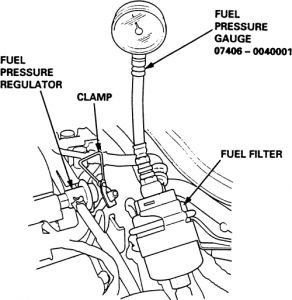CAUTION:
Observe all applicable safety precautions when working around fuel. Whenever servicing the fuel system, always work in a well ventilated area. Do not allow fuel spray or vapors to come in contact with a spark or open flame. Keep a dry chemical fire extinguisher near the work area. Always keep fuel in a container specifically designed for fuel storage; also, always properly seal fuel containers to avoid the possibility of fire or explosion.
CAUTION:
The fuel injection system remains under pressure, even after the engine has been turned OFF. The fuel system pressure MUST BE relieved before disconnecting any fuel lines. Failure to do so may result in fire and/or personal injury.
((Exploded view of an Acura fuel pump assembly))

REMOVAL/INSTALLATION:
Disconnect the negative battery cable.
Relieve the fuel pressure, as outlined earlier in this section.
Open the fuel tank filler cap to vent off pressure in the tank.
Remove the rear seat cushion.
Remove the rear access panel from the floor.
Detach the connector from the fuel pump.
WARNING:
Ensure that the battery is disconnected before any wires are removed.
Remove the fuel pump mounting nuts, then remove the fuel pump from the tank.
Installation is the reverse of the removal procedure. Test fuel pressure after installation is complete.
FUEL PRESSURE TESTING:
Relieve the fuel filler cap.
Remove the service bolt from the fuel filter.
Install a fuel pressure gauge.
Start the engine and measure the fuel pressure with the engine idling and the fuel pressure regulator vacuum line pinched off.
If the engine wont start, turn on the ignition switch ON, wait two seconds, then turn off the ignition switch OFF. Turn the ignition switch back ON again and read the fuel pressure.
The acceptable fuel pressure is 43.4-50.5 psi (299-348 kPa).
Reconnect the vacuum hose to the pressure regulator.
The fuel pressure should be 34.8-41.9 psi (240-289 kPa).
If the fuel pressure is higher than normal, inspect the fuel return hose for a clog or pinched area. Also check for a faulty fuel pressure regulator.
If the fuel pressure is lower than normal, inspect the system for a clogged fuel filter, faulty pressure regulator, or fuel line leakage.
Once the test is complete, perform the following:
Remove the fuel pressure gauge.
Install the service port bolt and tighten to 25 ft. lbs. (33 Nm).
Install the fuel filler cap.
((Checking fuel pressure with a gauge))

Hope this helps..
Thanks for using 2CarPros.com!
SPONSORED LINKS
Friday, January 16th, 2009 AT 1:56 AM

